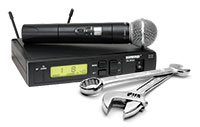 Wouldn’t it be great once we’ve gotten a new audio system up and running that it never required any attention? That’s probably the most frequent dream church sound techs have besides that brand new automated digital console, right? The fact is that even the best designed and installed sound systems require a tune-up every now and then to perform at their best.
Wouldn’t it be great once we’ve gotten a new audio system up and running that it never required any attention? That’s probably the most frequent dream church sound techs have besides that brand new automated digital console, right? The fact is that even the best designed and installed sound systems require a tune-up every now and then to perform at their best.
Before you break out the toolbox (or the checkbook), here are some basic troubleshooting steps:
- Identify your symptoms. This might seem more than obvious, but because components are interconnected with wires and powered by electricity, there are a number of places that your system might be failing. For example, have the Rice Krispie Brothers (Snap, Crackle, and Pop) and their idiot Uncle Hummer decided to take up residence in your system? Do wireless microphones drop reception? Have your high frequencies pulled an Elvis and left the building? Knowing the symptoms is most important, then you can deal with the fixes needed to tune the room up well.
- Assess your timing. How long has the system been misbehaving? Have you made any significant changes in your instrumentation or microphones? Have you added or removed a piece of equipment recently? Do you plan to stay in your current facility for quite a while longer? In the grand scheme of things, you might only need a temporary fix for now because you’re planning to upgrade equipment or move into a new facility in the near future.
- What is the REAL problem? Sometimes, we jump to conclusions and make the problem bigger than what it actually is. Are your microphone, drive lines, and equipment rack cables terminated and labeled correctly? Maybe you have electrical lines and audio lines too close to each other or they might actually be strapped together, which is an almost guaranteed problem waiting to happen. Is one or more of your speakers not functioning?
- Documentation and diagrams. If you don’t have an accurate hook-up diagram of your system, then you can’t really troubleshoot the system well. As previously mentioned, even if your entire system consists of a single powered speaker with an on-board mixer, there can still be an issue with electricity or a cable that has gone bad. Getting your documentation together is very important for your current system, particularly if you need to add more equipment to get the best performance.
- DSP. The most common problem in sound systems is the equalization of the loudspeaker system. If you’re still using an analog crossover or graphic equalizer, then your system could be in need of some upgraded processing. If your loudspeakers are still in good working order, the new DSP can make a huge difference in your system performance.
If you’ve followed these steps and still need some help pinpointing or fixing your problem, we offer a flat-rate Tune-Up service that can get your audio system in shape fast – just in time for those quickly-approaching Christmas services. Contact us today to make an appointment!
